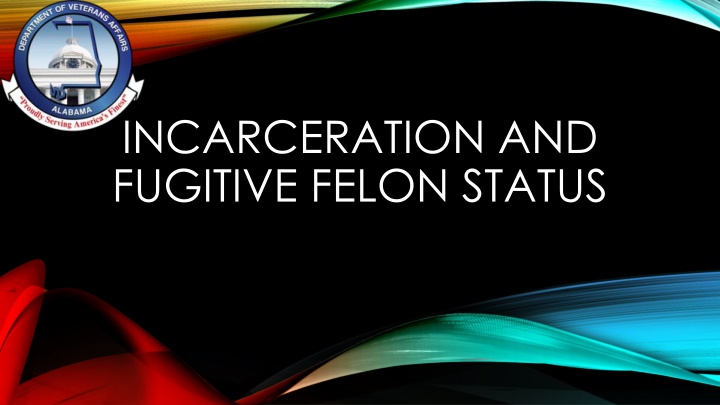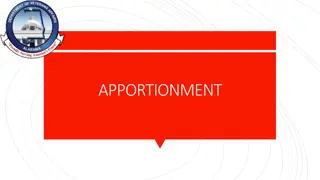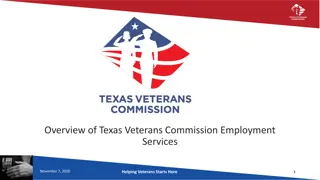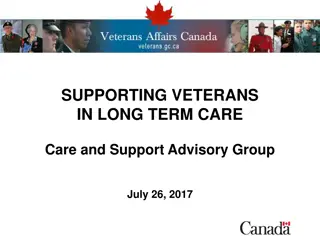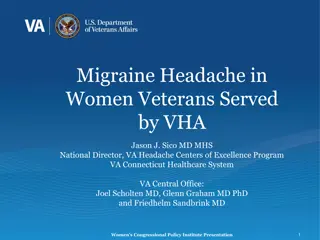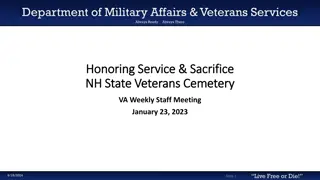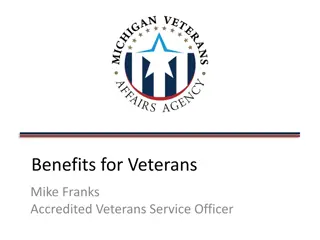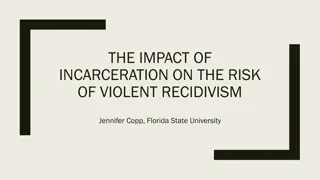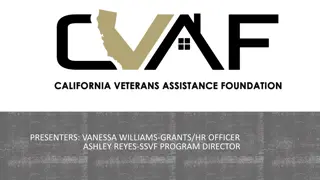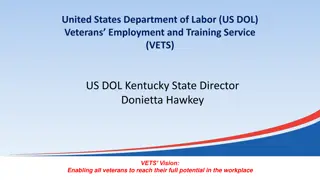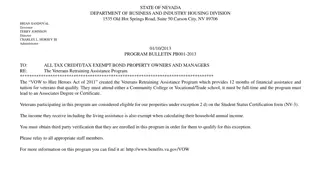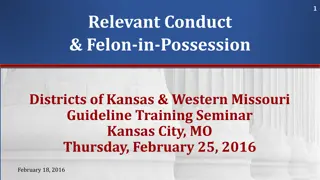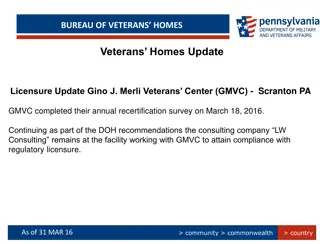Veterans Affairs: Incarceration and Fugitive Felon Status
V.A. guidelines on incarceration and fugitive felon status for veterans, including definitions, identification methods, benefit reductions, and implications on service-connected disability compensation.
Download Presentation

Please find below an Image/Link to download the presentation.
The content on the website is provided AS IS for your information and personal use only. It may not be sold, licensed, or shared on other websites without obtaining consent from the author.If you encounter any issues during the download, it is possible that the publisher has removed the file from their server.
You are allowed to download the files provided on this website for personal or commercial use, subject to the condition that they are used lawfully. All files are the property of their respective owners.
The content on the website is provided AS IS for your information and personal use only. It may not be sold, licensed, or shared on other websites without obtaining consent from the author.
E N D
Presentation Transcript
INCARCERATION AND FUGITIVE FELON STATUS
REFERENCES Title 38, U.S. Code, Chapters 15 and 53 Title 38, Code of Federal Regulations, Parts 3 and 4 Veterans Affairs Op. Gen Couns. Prec. 7-02 Adjudication Manual M21-1MR (Manual Rewrite), Parts 3 and 10
DEFINITIONS INCARCARATION THE V.A. considers a veteran to be incarcerated when following a conviction, they are in custody in a federal, state, or local penal institution, or a penal institution (any time spent in custody prior to trial, or during trial, does not count as incarceration for V.A. purposes). FUGITIVE FELON The V.A. has 3 categories: A veteran who has an outstanding warrant for a felony offense. A veteran violating a condition of probation or parole imposed for the commission of a felony. A veteran fleeing to avoid prosecution, or custody or confinement after conviction, for an offense or an attempt to commit an offense, which is a felony under the laws of the place from which the person has fled. A veteran fleeing to avoid prosecution, or custody or confinement after conviction, for an offense, or an attempt to commit an offense, which is a felony under the laws of the place from which the person flees.
HOW DOES THE V.A. KNOW? V.A. beneficiaries are required to notify the V.A. if they become incarcerated. The V.A., however, also identifies beneficiaries who are incarcerated or in fugitive felon status via listings received periodically from the U.S. Bureau of Prisons, Social Security Administration matches, and other data matching sources.
REDUCTION OF BENEFITS DURING INCARCERATION Different V.A. benefits are affected differently by incarceration. Some are reduced and others are terminated entirely. If a veteran is incarcerated for 61 days or more for a felony, the amount of service-connected disability compensation they will receive will be severely limited. If the veteran is rated at 20% or more disabled, the veteran will only be paid at the 10% level for the duration of their incarceration. If the veteran is rated at 10% disabled, the veteran will receive half of the 10% rate.
REDUCTIONS Reductions take effect after 61 days or more of incarceration. The 61st day is defined as 61 days after guilt is pronounced by a judge or jury and the beneficiary is incarcerated in a penal institution because of the determination of guilt. This only applies after a conviction of a felony. Even though the rate of compensation a beneficiary receives while incarcerated is reduced, the actual service-connected disability evaluation is not reduced.
INCARCERATION AND DEPENDENCY AND INDEMNITY COMPENSATION (DIC) The rules for payment of DIC benefits when a surviving dependent beneficiary is incarcerated for 61 days or more for a felony are the same as those for service-connected disability benefits.
NON-SERVICE-CONNECTED PENSION AND INCARCERATION Unlike recipients of disability compensation and DIC benefits, the V.A. completely terminates pension benefits to beneficiaries who are incarcerated for 61 days or more. Additionally, benefits are terminated for incarcerated pension beneficiaries whether they are incarcerated for a felony or a misdemeanor.
DUE PROCESS Once the V.A. has identified a beneficiary as being incarcerated, the V.A. will mail a due process letter to the beneficiary informing them that it has received information that he or she is incarcerated and that his or her benefits will be affected effective the 61st day of incarceration. The V.A. will state that the beneficiary has 60 days to provide the V.A. with evidence showing that the proposed action should not be taken, and if he or she waits more than 60 days to submit evidence, the evidence will be considered but the adjustment of benefits will already have gone into effect.
APPORTIONMENT OF BENEFITS DURING INCARCERATION Even though an incarcerated beneficiary of V.A. benefits receives only a portion or none of his or her benefit while incarcerated, the balance, or the full amount of the benefit, may be apportioned to his or her family during the period of incarceration. For an incarcerated beneficiary of service-connected disability compensation or DIC benefits, the remainder of the benefit not received by the beneficiary may be apportioned to his or her family. The amount apportioned will be determined based on need. In determining need , factors such as the apportionee claimant s income, living expenses, and any special needs of any dependent(s) will be considered.
APPORTIONMENT OF BENEFITS DURING INCARCERATION Even though an incarcerated non-service-connected pension benefit recipient may not receive any benefits while incarcerated, their full benefits may still be apportioned to his or her family. An application for apportionment should be made promptly upon the incarceration of the beneficiary. Apportionment may not be granted retroactively.
RESUMING BENEFITS UPON RELEASE FROM INCARCERATION The V.A. will not automatically resume paying benefits at full entitlement once a beneficiary has been released from incarceration. The beneficiary must inform the V.A. of his or her release by an approved method. A specific V.A. form is not required to report that the incarceration has ended. The beneficiary may report his/her release in writing, by telephone, email, fax, or eBenefits, and should include evidence to support this. Acceptable evidence are the following:
ACCEPTABLE EVIDENCE A letter from his or her parole agent showing the dates of incarceration and whether the conviction was for a felony or a misdemeanor. The beneficiary should submit the letter with an original signature, not a copy. If the beneficiary was not released on parole, he or she can contact the jail or prison where they were incarcerated and get a letter identical to the one above signed by a jail or prison official.
FUGITIVE FELONS AND RECEIPT OF V.A. BENEFITS As noted above, the V.A. uses the term fugitive felon to refer to three categories of people that may be subject to felony proceedings. It does not mean that the person is intentionally trying to escape prosecution.
REDUCTION OF BENEFITS WHILE IN FUGITIVE FELON STATUS The V.A. completely terminates all benefit payments to a veteran, or survivor of a veteran, while he or she is a fugitive felon. The V.A. will also terminate all benefits payments to dependents while either the dependent or the veteran is in fugitive felon status. This rule applies to the following V.A. benefits: Service-connected disability compensation, DIC, Non-service-connected pension, Medical care, Life insurance, Vocational rehabilitation, and Educational benefits. NOTE: No apportionment is allowed.
DEPENDENTS AND FUGITIVE FELON STATUS If a surviving spouse receiving DIC or improved death pension becomes a fugitive felon, the entire benefit is terminated including any additional benefits that the surviving spouse may be receiving for the children of the veteran. The children of the veteran, however, would then have independent eligibility for death pension or DIC benefits.
FUGITIVE FELON DUE PROCESS Once the V.A. has identified a beneficiary as being in fugitive felon status, it will mail a letter to the beneficiary informing them of their alleged status and the termination of all V.A. healthcare and benefits. The beneficiary has 60 days to provide the VA with evidence that the warrant has been cleared or else it will terminate all benefits as of the date of the warrant. If the beneficiary believes that he or she has been identified as being in fugitive felon status incorrectly, he or she must contact the originating agency that issued the warrant to get proof that an error was made (i.e., mistaken identity), that the warrant should be canceled, that the warrant has been satisfied by his or her arrest or surrender, or that there are other reasons which would resolve the warrant.
RESUMING BENEFITS WHEN A PERSON IS NO LONGER IN FUGITIVE FELON STATUS The V.A. will not resume payments automatically. The veteran must provide evidence that the fugitive status has been cleared. Uncorroborated statements by the beneficiary, or even an attorney, will not suffice. When a person is no longer in fugitive felon status, in order to resume benefits, he or she must submit official documentation such as a court order or a letter from a warrant agency.
SUMMARY Help your veterans understand the benefit-related consequences that incarceration and felony status have on their families and themselves. Understand the processes and terminology the V.A. uses for these issues. Know the procedures for helping veterans restore their benefits when they are eligible.
